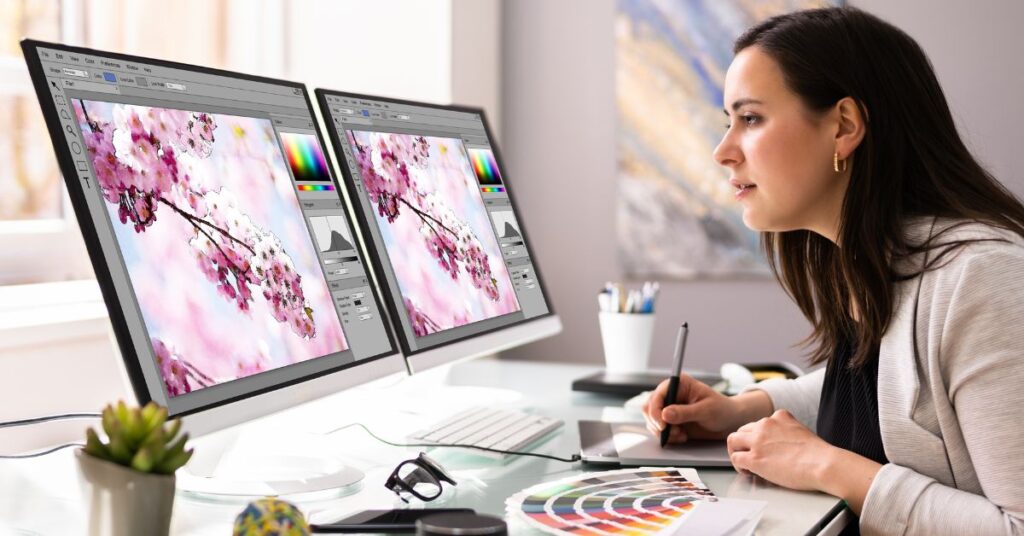How to Build a Freelance Career in Graphic Design (Step-by-Step)

Introduction: Why Freelance Graphic Design Is a Career Worth Pursuing
The freelance graphic design industry has experienced explosive growth in recent years, thanks to the global change towards distance work, digital branding, and flexible career models. Businesses now operate more online than ever, and their requirement for visual branding, website design, social media creative, and digital campaign is more than at any other point in history. For creative professionals, it presents an incredible opportunity. Freelancing in graphic design is not only about working independently – it’s about the manufacture of an individual brand, which works meaningfully for customers worldwide, and is gaining freedom to shape its career.
However, starting a freelance career is not as simple as buying design software and declaring your services. Success in this field requires a deliberate approach that mixes creativity, technical expertise, customer communication skills, and business skills.
Understanding the Freelance Graphic Design Landscape
Before diving into freelancing, it is important to understand the current market trends. The demand for graphic designers extends in many areas- branding, advertising, web design, UI/UX, packaging, publication, and even motion graphics and 3D modeling.
Unlike traditional employment, freelancing allows you to work with a diverse range of customers, a logo for global corporations that start major marketing campaigns to small startups. The trade-off is that you are responsible for your own income stability, project sourcing, and client retention. This flexibility is appealing to many people, but it requires discipline and a strategic plan.

Assuming that the industry is constantly developing with new devices, design styles, and the customer’s expectations is important to remain relevant and competitive.
Step 1: Building Your Design Skills and Specialization
The foundation of a successful freelance career in graphic design is your skill. While basic design theory- color Theory, Typography, Creation – are essential, expertise can separate you. For example, you can focus on web design, brand identity, digital illustration, or social media graphics.
Expertise does not mean ignoring other skills; Instead, it means that a position herself as an expert in a particular location while remaining versatile enough to handle diverse projects. Continuous education plays an important role here. Online courses, design boot camps, and tutorials can help you intensify your skills. Stay updated with design trends – such as minimalism, bold typography, or 3D visuals – and your work resonates with modern audiences.
Step 2: Creating a Portfolio That Speaks for You
Your portfolio is your most powerful marketing tool. It serves as visual evidence of your abilities, style, and professionalism. Potential customers often decide to hire a designer on the basis of their portfolio alone, so the investment of time and effort here is non-negotiable.
A strong portfolio should include a variety of projects that display your limits, but also clearly highlight your field of expertise. Instead of displaying only designed designs, consider presenting them as a case study – the problem, your creative process, and interpretation of the solution given by you. The approach to this storytelling helps potentially to understand the value that is brought beyond the aesthetics.
Even if you lack new and paid client work, you can create self-affected projects. Designing branding for a fictional company, redesigning an existing brand identity, or creating a social media campaign for a reason can display your skills and creativity.
Step 3: Establishing Your Personal Brand
Freelancing in graphic design is highly competitive, and customers often choose designers who stand out through their individual brands. Your brand is more than a logo or color scheme – this notion is your style, professionalism, and the reliability of customers.
This includes creating a consistent visual identification for yourself on your website, social media, email signature, and marketing materials. Communication, your tone of accountability, and the way you present your work contribute to your personal brand. Creating yourself as an expert with a unique voice and aesthetic style helps you attract customers who align with your vision.
Step 4: Setting Up Your Business Infrastructure
Freelancing is as much about running a business as it is about creating a design. This means installing the infrastructure requires you to operate smoothly. You will need a professional website to show your portfolio, an invoice system to handle paying, and you and your customers to protect a contract template.
It is also important to decide your pricing strategy. You can offer an hour, per project, or a retainer package for ongoing work. Researching industry rates and considering the level of your experience will help you find a competitive yet durable pricing model. Additionally, establishing a dedicated task environment, whether it is at home or at a coworking location, will help you to be productive and focused.
Step 5: Finding Your First Clients
Getting off your first customers is often the most challenging part of freelancing. Initially, you may need to be active in reaching potential customers instead of waiting to find them. Networking can be both online and offline -valuable. Participating in industry events, joining design communities, and participating in social media conversations about design can help you create connections.
Freelance marketplace stones such as Upwork, Fiverr, and Freelancer can be stones, but they are often competitive. Offering free value through cold emails, blog posts, or design tips, and can also open doors by joining with small businesses in your area. Once you secure some customers and provide extraordinary work, the referral can become one of your strongest lead sources.
Step 6: Mastering Client Communication and Project Management
Strong design skills can see you, but effective communication keeps coming back to customers. From initial inquiry to project delivery, it is necessary to demonstrate your ability to listen to the needs of the client and manage expectations.
Establishment of a clear project timeline, delivery, and payment terms from the start prevents misunderstandings. Project management tools such as Trello, Asana, or Notion can help you stay organized, especially when many projects are handled. Being transparent about progress and receptive to the response creates confidence, and satisfied customers often turn into repeat customers or long-term partners.
Step 7: Marketing Yourself Consistently
A stable stream of customers comes from persistent marketing efforts. Social media platforms such as Instagram, LinkedIn, and Behance allow you to showcase your work and reach potential customers. Writing a blog post or making video tutorials can establish you as an authority in your niche, which attracts customers who give importance to your expertise.
Email marketing is another powerful tool, especially to stay in contact with previous customers and leads. Regular updates, tips, or sharing pieces of a new portfolio can keep you top-of-mind. The key is to maintain a consistent appearance so that when someone needs a graphic designer, you are the first person.
Step 8: Continuing to Learn and Adapt
The design industry develops rapidly, with new equipment, trends, and technologies. Staying forward means being committed to learning for life. Using new software, searching for emerging trends such as A-assisted designs, and studying the work of successful designers can keep your skills sharp.
Participating in workshops, webinars, and design conferences not only enhances your skills but also expands your professional network. As you grow, consider expanding your services, cooperating with other creatives, or even mentioning new designers.
Step 9: Scaling Your Freelance Career
Once you have a stable customer base and a strong reputation, you can think of scaling your freelance career. This may mean increasing your rates, offering premium services, or collaborating with other freelancers to take large projects. Some designers eventually become infected with running their own design agencies, hiring other creatives to help handle the workload.

Scaling involves streamlining your procedures, automating repetitive tasks, and focusing on high-value customers. The goal is to increase your income by maintaining the quality of your work and balance in your lifestyle.
Conclusion: Building a Sustainable Freelance Graphic Design Career
A freelance career in graphic design provides unmatched creative freedom and adequate income capacity, but it also comes with challenges that require careful planning and perseverance. By honoring your skills, creating a compelling portfolio, establishing a strong personal brand, and continuously marketing yourself, you can create a prosperous business that aligns with your creative passion.
The journey of freelancers installed from interested designers is not immediate-it is a gradual process of development, adaptation, and relationship. With dedication, constant learning, and focusing on giving value to customers, you can convert your passion for design into a permanent and rewarding career that develops with a changing creative landscape.







Leave a Reply